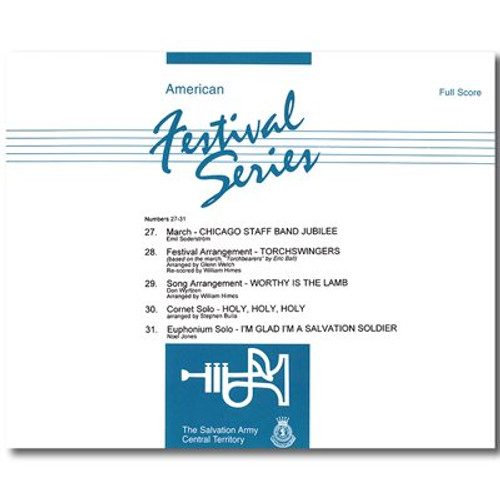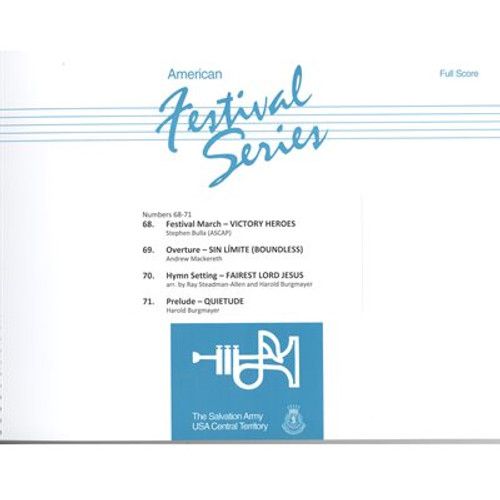Product Description
December 2001 Nos. 27-31
Comments by
Staff Bandmaster William Himes
Music & Gospel Arts Secretary, USA Central Territory
Score Sample(view series guide)
27. March - Chicago Staff Band Jubilee Emil Soderstr?m Notes 28. Festival Arrangement - Torchswingers (Torchbearers) arr. Glenn Welch, Re-scored William Himes Notes 29. Song Arrangement - Worth is the Lamb Don Wyrtzen, arr. William Himes Notes 30. Cornet Solo - Holy, Holy, Holy Stephen Bulla Notes 31. Euphonium Solo - I'm Glad I'm a Salvation Soldier Noel Jones Notes
Produced by The Salvation Army - Central Territory27. March - Chicago Staff Band Jubilee
Program Note:
Composed at the time of the Chicago Staff Band's fiftieth anniversary in 1957, this march features two melodies especially significant to the band on that occasion: "O God, our help in ages past" (St. Anne) and "Following Jesus."Note to the Conductor:
Although this march was written more than forty-five years ago, it has not lost its vitality or audience appeal. In addition to the technical challenges one anticipates in the music of Emil Soderstr?m, the composer has employed counter-melody to a much greater degree than many of his other marches from this era.
Therefore the main objective will be to balance melody with counter melody while keeping rhythmic and harmonic parts at a supportive level so as not clutter up the sonic landscape. This is particularly true of bars 14-22 and 55-70, where original counter melodies are presented with the themes, "St. Anne" and "Following Jesus," respectively.
Otherwise, carefully observing dynamic and articulation effects will result in a successful interpretation and performance.28. Festival Arrangement - Torchswingers
Program Note:
Eric Ball's classic march, "Torchbearers," first published in 1933, is transformed in this stetting arranged in swing style.Note to the Conductor:
This swing approach to Eric Ball's march classic is likely to raise a few eyebrows on the faces of SA music purists. However, there are two points to be made regarding the viabiity of this setting: First, as a close friend of Eric Ball, I had the opportunity to discuss this arrangement with him in 1987 (yes, it has been around that long!) and he was delighted with the idea and gave his enthusiastic blessing.
Secondly, one of the characteristics of great music is the ability to be reworked in many forms and idioms. The swing vocal settings of Bach and Mozart by the Swingle Singers, and Duke Ellington's transformation of Tchaikovsky's Nutcracker are two examples that quickly come to mind. In this context there can be no doubt that Torchswingers is equally credible.
That being said, here are a few technical points to keep in mind when rehearsing:
Bar 8: Make sure the trombone smears have lots of character, starting ahead of the beat and well below the pitch destination (at least from third to first position.)
Bars 21-22: Be attentive to the pp entry in soprano, solo and second cornets, with its controlled crescendo, to create and effective nuance.
Bars 37-39: Carefully balance the trombone bell-tones as a background to the cornet/euphonium melody.
Bars 51-64: The trombone solo is intended to be played quite literally, while still sounding improvised. The solo will be more effective acoustically and visually if performed standing.
Bar 87: Note the rhythmic timing of the smear in the first and second trombones. It is important that this be played precisely together otherwise the effect will be lost.
In general: There are two major factors that can affect a successful performance: First, a steady, authentic and tasteful swing style provided by the drum kit. Besides establishing the tempo and style, the drum kit is virtually the driving force behind the entire piece. Equally impotant is the band's attention to the abundant articulations and dynamic effects needed to assure an authentic jazz/swing style.29. Song Arrangement - Worthy is the Lamb
Program Note:
A meditative setting of Don Wyrtzen's song based on Revelation 5:12:
"Worthy is the Lamb that was slain to receive power and riches and wisdom and strength, honor and glory and blessing."Note to the Conductor:
While this setting poses few technical challenges, the range of intensity calls for a restrained, flowing approach, carefully scoping the crescendos to forte at bar 27 and the ultimate fortissimo peak at bar 63.30. Cornet Solo - Holy, Holy, Holy
Program Note:
The immortal hymn tune, "Nic?a," of John Dykes (1823-1896) is presented in this worshipful and contemporary tone solo for cornet and band.Note to the Conductor:
This solo was arranged for Chris Jaudes, trumpet/cornet soloist from Montclare, New Jersey. The light rock setting (with emphasis on light) is straightforward, yet full of subtlety. Make certain the tempo (76 beats per minute) is steady and unhurried.
Contemporary rhythms must be played with unity and precision, while avoiding the tendency to be heavy or punchy - as exemplified in the opening four bars. This is best achieved when players mentally subdivide the beats into sixteenths (semi-quavers). this also applies to the interplay between first horn and first baritone at bars 24-25. Again, precision is the objective.
Beyond these points, the prime consideration is the obvious: to keep the accompaniment balanced and at a supportive volume level so that the soloist can be easily heard at all times. This is especially true of the forte section at bars 36-40.31. Euphonium Solo - I'm Glad I'm a Salvation Soldier
Program Note:
This sparkling variation solo, based on the Salvation Army chorus of the same name, Was written especially for Karl Strand, Chicago Staff Band euphonium soloist following the band's tour of Australia in 1991.Note to the Conductor:
The cheery, waltz-like chorus, "I'm glad I'm a salvation soldier," is the basis for this theme-and-variation solo, providing the soloist ample opportunity to display and expressive, lyrical style as well as dazzling technique.
The band accompaniment is quite accessible, presenting few technical challenges. the only specific suggestion would be for the conductor to carefully assess the tempo of the final variation beginning at bar 76 (126 beats per minute) as as not to get too fast too soon. There is a slight accelerando at bar 97 - but only to 138. This will leave room for the final sprint to the finish (144 beats per minute) beginning at bar 123.
The final three bars should make full use of the molto ritard as well as the cymbal crescendo for a suitably dramatic conclusion.







